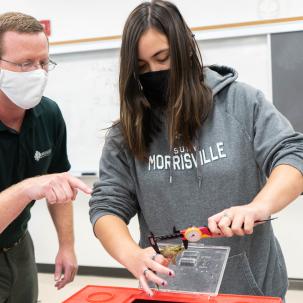MORRISVILLE, N.Y. — Before they go out into the field to study reptiles and amphibians, students in Associate Professor Eric Diefenbacher’s Herpetology class get an indoor lesson in how to safely handle them.
A table lined with frogs, lizards and snakes in captive tanks set the scene for one of his first classroom lessons this semester, a real-life learning exercise for students who will venture out to study the creatures in their natural habitat in the coming weeks.
In-between instructions on how to handle, safely collect and properly measure them, Diefenbacher entwined interesting facts about each one, sharing his vast herpetology knowledge.
Among the classroom visitors were some from Diefenbacher’s domestic collection — a Nelson’s milk snake, crested gecko and blue-tongued skink (lizard), while others were caught in the wild — a redbelly snake, Eastern garter snakes, adult wood frog, green frog tadpoles and adult green frogs.
Diefenbacher’s class is one of the ways students gain valuable field skills and get an opportunity to explore different career choices. The work they do also provides important research for sites they visit.
The popular class, a requirement for certain majors, is also offered as an elective. Alyssa Derr chose the class to augment her natural resources conservation (NRC) associate degree. Derr switched gears during the pandemic, trading in her art history degree for one in NRC and a chance to eventually pursue pest management and invasive species management.
“It will be good for me to know what is around and what I may face in the field,” she said. “Everything I learn can be applied in the future.”
Her own fascination with reptiles started 22 years ago with a pet ball python. Captivated by the snakes Diefenbacher brought to class, her eyes were on the skink. “I have never seen a skink and the one in front of me is pretty amazing,” she said.
“Everything they learn here they can apply directly in the field,” Diefenbacher said. “When they go out into their careers, they will have all of the knowledge to do things properly.”
Diefenbacher, of Norwich, an organismal biologist specializing in herpetology with a background in regenerative/developmental biology, ecology and natural history, teaches at both the SUNY Morrisville and Norwich campuses.
“As a practitioner in applied learning I enjoy and utilize research in my classes to enhance regular course work both during lecture and labs,” he said. “I operate an undergraduate research lab whereby students can further their resume by taking part in a wide variety of projects and potentially get college credit for doing so.”
Projects have ranged from salamander assemblages, aquatic drone efficacy in turtle surveillance, helping local entrepreneurs create better fungus-growing kits for educators nationwide, aquatic system health and monitoring, as well as others which have received local and state level recognition.
Students in his lab have published in scientific journals and received presentation awards at several local and statewide research conferences.
Diefenbacher also collaborates with local environmental agencies, non-profit organizations, school districts and teachers to enhance educational delivery on a wide range of biological topics.

